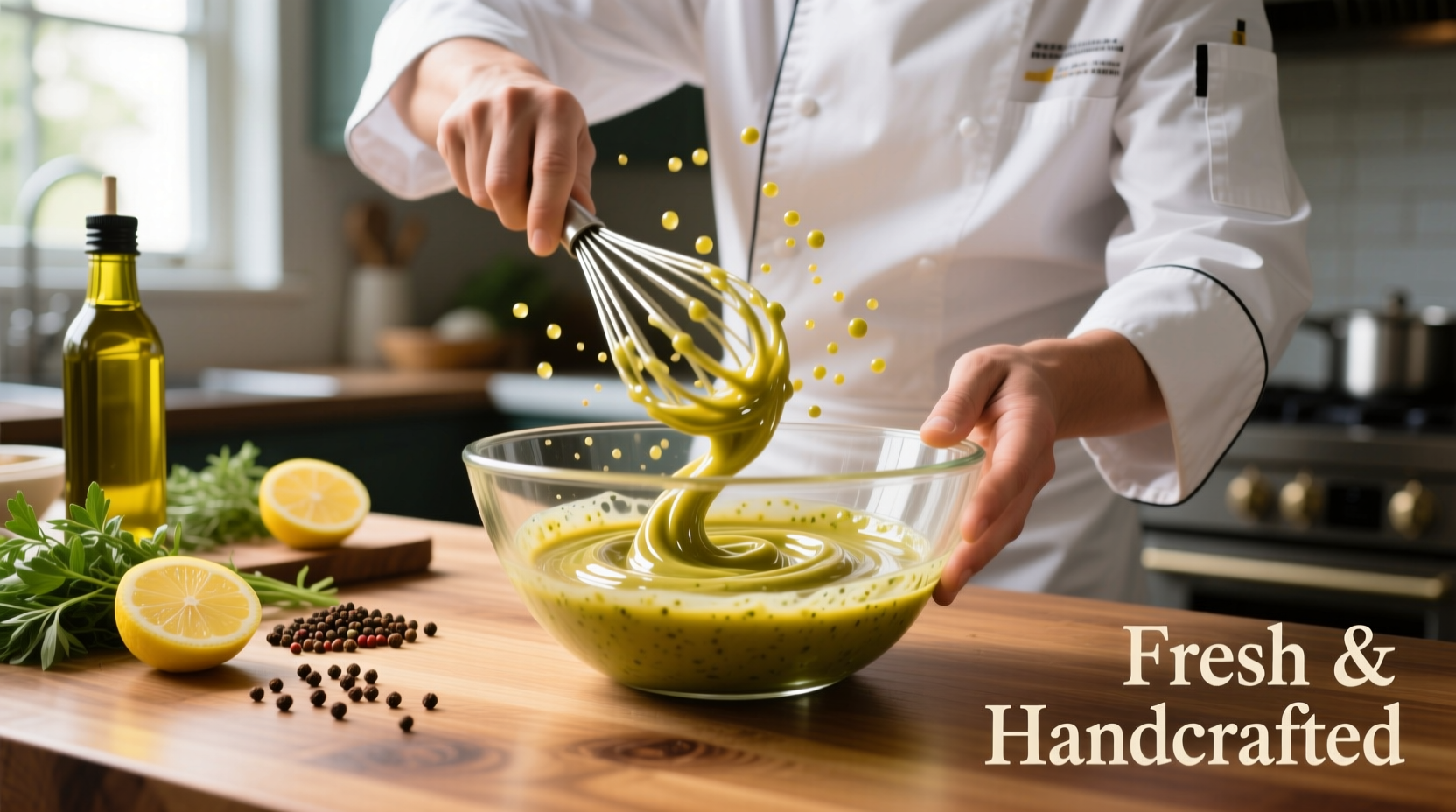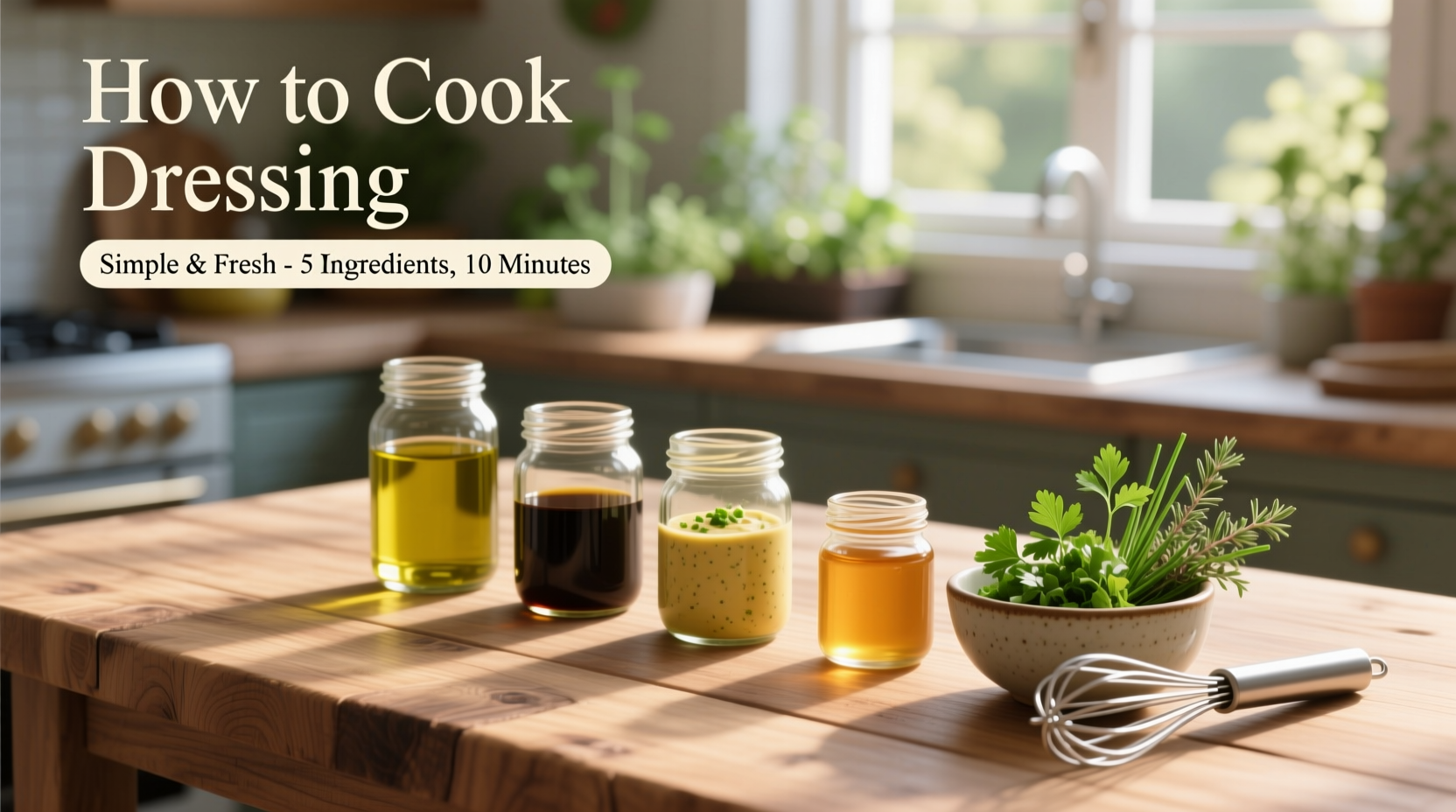Creating exceptional dressing requires understanding just three fundamental elements: the proper oil-to-acid ratio, effective emulsification techniques, and balanced seasoning. Whether you're making a classic vinaigrette or creamy herb dressing, these principles ensure consistent results every time you whisk ingredients together.
Why Homemade Dressing Beats Store-Bought Every Time
Commercial dressings often contain stabilizers, preservatives, and excessive sugar that compromise both flavor and nutritional value. When you make dressing at home, you control every ingredient—resulting in fresher taste, better texture, and customized flavor profiles that elevate simple salads into memorable meals. According to the U.S. Food and Drug Administration, homemade dressings typically contain 30-50% less sodium and sugar than their store-bought counterparts.
Your Essential Dressing Toolkit
Before you start mixing, gather these kitchen essentials that professional chefs rely on for perfect dressing every time:
- Medium-sized glass mixing bowl (glass won't absorb flavors)
- Whisk with flexible wires for thorough emulsification
- Measuring spoons and cups for precise ratios
- Small jar with tight-fitting lid for storage and shaking
- Microplane grater for fresh garlic and citrus zest

The Science of Perfect Dressing Ratios
Understanding the chemistry behind dressing composition separates good from exceptional. The Culinary Institute of America's research confirms that the ideal foundation for most vinaigrettes follows a precise 3:1 ratio of oil to acid. This balance prevents the dressing from tasting either greasy or overly tart.
| Dressing Type | Oil | Acid | Emulsifier | Special Notes |
|---|---|---|---|---|
| Classic Vinaigrette | 3 parts | 1 part | 1 tsp Dijon mustard | Add shallots for complexity |
| Creamy Ranch | 2 parts | 1 part | 2 parts mayonnaise/sour cream | Use buttermilk for tang |
| Asian Sesame | 2 parts | 1.5 parts | 1 tbsp tahini | Add rice vinegar for brightness |
Step-by-Step Dressing Preparation Process
Step 1: Select Your Foundation Ingredients
Choose high-quality components that form the backbone of your dressing. For oil-based dressings, extra virgin olive oil provides robust flavor for Mediterranean styles, while neutral oils like grapeseed work better for Asian-inspired dressings. Acids should be fresh—bottled citrus juice lacks the vibrant flavor of freshly squeezed lemons or limes. The University of California's Agriculture and Natural Resources department confirms that freshly squeezed citrus contains up to 30% more vitamin C and volatile compounds that enhance flavor perception.
Step 2: Proper Emulsification Technique
This is where most home cooks fail. Emulsification requires gradually incorporating oil into the acid mixture while continuously whisking. Start with your acid component in the bowl, then slowly drizzle in oil while whisking vigorously in a circular motion. The key is patience—adding oil too quickly causes separation. Professional chefs use the "French whisk" technique: holding the bowl steady with one hand while making small, rapid circles with the whisk in the other.
Step 3: Flavor Development and Balancing
After emulsifying your base, it's time to build flavor layers. Add sweet elements (honey, maple syrup) to counter acidity, salt to enhance all flavors, and aromatics (garlic, herbs) for complexity. Always taste and adjust—dressings should have a harmonious balance where no single element dominates. Remember that flavors mellow slightly after resting, so your dressing should taste slightly stronger than desired when first made.
Avoiding Common Dressing Mistakes
Even experienced cooks encounter these frequent pitfalls. Understanding why they happen helps you prevent them:
- Separation: Caused by improper emulsification or temperature shock. Solution: Always use room temperature ingredients and add oil gradually while whisking constantly.
- Overly acidic taste: Results from incorrect ratios or poor quality vinegar. Solution: Follow the 3:1 ratio and use high-quality acids; balance with a pinch of sugar if needed.
- Bland flavor: Often from insufficient seasoning or stale ingredients. Solution: Use fresh herbs and spices; season in layers, tasting as you go.
Four Restaurant-Worthy Dressing Variations
Classic French Vinaigrette
Combine 3 parts extra virgin olive oil with 1 part red wine vinegar, 1 teaspoon Dijon mustard, 1 minced shallot, salt, and freshly ground pepper. Whisk until emulsified. Let rest 30 minutes for flavors to meld. This timeless dressing works perfectly with bitter greens like arugula and radicchio.
Lemon-Herb Buttermilk Dressing
Whisk together 1/2 cup buttermilk, 1/4 cup mayonnaise, 2 tablespoons fresh lemon juice, 1 minced garlic clove, 2 tablespoons chopped fresh dill, 1 tablespoon chopped chives, salt, and pepper. This creamy dressing maintains its texture better than yogurt-based versions and complements grilled vegetables beautifully.
Asian Sesame-Ginger Dressing
Combine 1/4 cup neutral oil, 2 tablespoons rice vinegar, 1 tablespoon soy sauce, 1 tablespoon sesame oil, 1 teaspoon honey, 1 teaspoon freshly grated ginger, and 1 minced garlic clove. The key to authentic Asian dressings is using toasted sesame oil sparingly—it's potent and can easily dominate other flavors.
Balsamic Reduction Dressing
Simmer 1/2 cup balsamic vinegar until reduced by half and syrupy. Cool completely, then whisk with 3/4 cup extra virgin olive oil, 1 minced shallot, and salt. The reduction process concentrates flavors and creates natural sweetness without added sugar—a technique perfected by Italian chefs over centuries.
Proper Storage and Usage Tips
Homemade dressings lack the preservatives found in commercial products, so proper storage is crucial. Most oil-based vinaigrettes keep for 1-2 weeks in the refrigerator, while creamy dressings last 5-7 days. Always store in airtight containers—the small headspace in a mason jar works perfectly. Before using separated dressings, simply shake vigorously or re-whisk. For best flavor, bring dressings to room temperature before serving, as cold temperatures mute flavor perception.
Troubleshooting Guide
Encountering issues with your dressing? These quick fixes solve common problems:
- Dressing is too thin: Add 1/2 teaspoon xanthan gum or an extra teaspoon of Dijon mustard and whisk vigorously.
- Dressing is too thick: Gradually whisk in small amounts of water or additional acid until desired consistency.
- Dressing tastes flat: Add a pinch of salt and a small squeeze of citrus—these enhance existing flavors without changing the profile.
- Dressing separated: Start with a fresh emulsifier (mustard or egg yolk) in a clean bowl, then slowly whisk in the separated dressing as if making a new emulsion.











 浙公网安备
33010002000092号
浙公网安备
33010002000092号 浙B2-20120091-4
浙B2-20120091-4